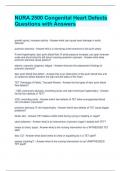NURA 2500 Congenital Heart Defects
Questions with Answers
growth spurts, increase activity - Answer-what can cause heart damage in aortic
stenosis
pulmonic stenosis - Answer-this is a narrowing at the entrance to the pulm artery
R vent hypertrophy, decr pulm blood flow, R atrial pressure increase, can open foramen
ovale and shunt blood to left atrium causing systemic cyanosis - Answer-what does
pulmonic stenosis cause (patho)?
edema, cyanosis, dyspnea, fatigue - Answer-what are the assessment findings of
pulmonic stenosis?
decr pulm blood flow defect - Answer-this is an obstruction of the pulm blood flow and
an anatomic defect between the right and left sides of the heart
TET (Tetralogy of Fallot), Tricuspid Atresia - Answer-list the types of decr pulm blood
flow defects?
- VSD, pulmonary stenosis, overriding aorta, and right ventricular hypertrophy - Answer-
list the four defects of TET?
VSD, overriding aorta - Answer-which two defects of TET allow unoxygenated blood
into circulation (cyanosis)?
pulmonic stenosis, R vent hypertrophy - Answer-which two defects of TET cause bigger
problems?
bluish skin - Answer-TET babies exhibit what during crying or feeding or vagal?
stool softeners - Answer-what is an intervention of prevent vagal in babies with TET?
knees to chest, squat - Answer-what is the nursing intervention for a WITNESSED TET
spell
decr CO - Answer-what does knees to chest or squatting do in a TET spell?
assess (choking?) - Answer-what is the nursing intervention for an UNWITNESSED
TET spell?
, Tricuspid Atresia - Answer-this is failure to the tricuspid valve to develop
Transposition of the great arteries or vessels - Answer-this is a defect where the pulm
artery leave the left vent and the aorta exits the right vent with no communication
between systemic and pulmonic circulation
trunks arteriosus - Answer-this defect is failure to develop normal pulm artery and sort
resulting in a single vessel that overrides both vent
retarded growth, murmur, fatigue, upper resp infection, dyspnea, tachycardia,
tachypnea, clubbing, squatting, hypercyanotic spells - Answer-what are the general
physical consequences of congenital defects?
chromosomal, genetic, maternal factors - Answer-what are the risk factors for CHD
(congenital heart defects)?
drug use, fetal exposure to drugs, environ. toxins, viral illness, rubella, metabolic
disorders, increase maternal age - Answer-what are the maternal risk factors for CHD?
1st seven weeks of pregnancy - Answer-what gestational age does rubella increase the
risk for CHD?
lithium, alcohol, warfarin - Answer-what maternal drug use increases the risk of CHD?
DM, incr Ca - Answer-what maternal metabolic disorders increase the risk for CHD?
murmur - Answer-what is often the first sign of CHD?
murmur, symptoms either immediately after umbilical cord or several days,
asymptomatic - Answer-what is the presentation of CHD?
blood, pulse ox, X-ray, CT, MRI, EKG, Echo, cath, Exercise test - Answer-what are the
diagnostic studies of CHD?
Echo - Answer-what is the gold standard of diagnostic tests for CHD that shows the
structures and hemodynamics of the heart?
incr pulm blood flow - Answer-this is a defect that allows the blood to flow from higher
pressure LEFT to lower pressure RIGHT
left to right - Answer-which was does blood flow in incr pulm blood flow defects?
septum, great vessels - Answer-where are the abnormal connections in incr pulm blood
flow defects?




